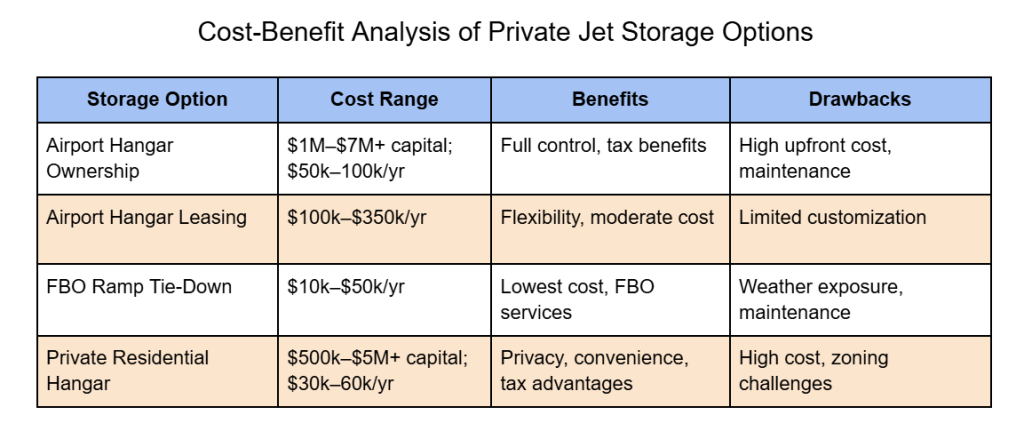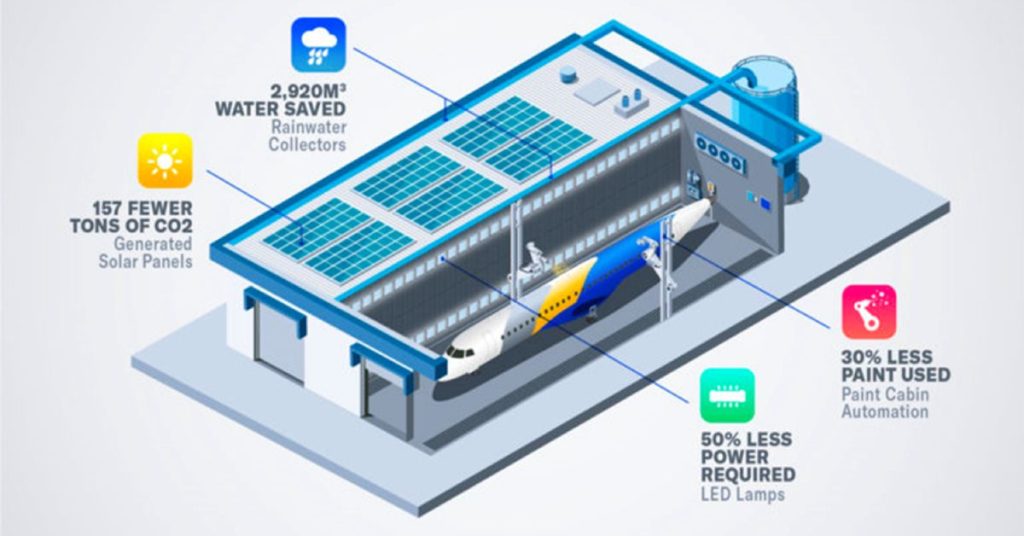The global private aviation sector has witnessed substantial growth over the past decade, driven by increasing demand from high-net-worth individuals, corporations, and luxury travelers seeking flexibility, privacy, and efficiency. According to industry data, the private jet fleet has expanded by over 15% between 2018 and 2023, with projections indicating continued growth fueled by emerging markets and technological advancements in jet manufacturing.
A critical, yet often overlooked, aspect of private jet ownership and operation is the storage and parking of these aircraft. Proper storage solutions are essential not only for safeguarding the asset but also for optimizing operational efficiency, maintenance accessibility, and privacy. Consequently, the question “Where do people keep their private jets?” has become increasingly relevant for owners, operators, and service providers aiming to make strategic decisions.
This article provides a comprehensive analysis of current trends, storage options, and geographic preferences regarding private jet storage. Leveraging industry statistics and cost-benefit analyses, it aims to equip stakeholders with actionable insights for informed decision-making in luxury aviation. From airport hangars and fixed-base operator (FBO) facilities to private residential hangars, we explore where owners choose to store their jets and why these choices matter in the broader context of private aviation strategy.
Where Do People Keep Their Private Jets?
Private jet owners and operators select storage locations based on a complex interplay of operational needs, geographic convenience, cost considerations, and privacy requirements. The question “Where do people keep their private jets?” encompasses several primary storage solutions: airport hangars, Fixed Base Operator (FBO) facilities, private hangars on estates or business campuses — facilities often used not just for luxury travel but also specialized services such as air ambulance operations. Learn about the best air ambulance services in India here.
This section analyzes these options, backed by industry statistics and trend data, to provide a clear understanding of private jet storage preferences worldwide.
Airport Hangars: The Traditional Hub
The most common storage option for private jets is at airport hangars, which vary from publicly operated municipal hangars to highly specialized private hangars owned by corporations or individuals. According to the General Aviation Manufacturers Association (GAMA), approximately 60% of private jets worldwide are housed in hangars located at airports with dedicated business aviation terminals.

These hangars provide critical protection from weather, enhance aircraft security, and facilitate maintenance operations. Major private jet hubs such as Teterboro Airport (New Jersey), Van Nuys Airport (California), and London Luton Airport in the UK boast extensive hangar infrastructure with high occupancy rates exceeding 85%. This trend reflects limited availability and increasing demand for premium hangar space in prime locations.
Fixed Base Operator (FBO) Facilities: Flexible and Service-Oriented
FBOs offer private jet owners a combination of parking space, refueling, maintenance, and concierge services. While many FBOs provide covered hangar space, a significant portion of private jets are stored on outdoor ramps or tied down, particularly in regions with milder climates such as Florida or the Mediterranean. According to WingX Advance, 40% of private jets in the U.S. spend some time on FBO ramps rather than permanent hangars, mainly due to cost savings and flexible scheduling.

However, outdoor storage increases exposure to weather-related wear and can elevate maintenance costs over time. This trade-off is a critical factor for owners weighing cost versus aircraft preservation when deciding where to keep their private jets.
Private Hangars: Increasing Popularity of Ownership
There is a notable trend towards the construction of private hangars on residential properties or dedicated aviation estates. This option appeals primarily to ultra-high-net-worth individuals who prioritize privacy, convenience, and direct access. Explore some of the most luxurious billionaire private jets here. Data from Jetcraft indicates a 20% annual growth rate in private hangar construction in North America and Europe between 2020 and 2024.

These private hangars often feature state-of-the-art security systems, climate control, and bespoke maintenance setups. While the upfront capital investment can range from $500,000 to several million dollars depending on size and location, owners benefit from long-term cost control and asset protection. In addition, tax advantages are often available for hangar construction depending on jurisdiction, adding a strategic financial incentive.
Third-Party Hangar Leasing: Flexibility and Scalability
Leasing hangar space from third-party providers or airport authorities has gained traction as a flexible, lower-commitment alternative to ownership. The global market for hangar leasing is estimated at $1.5 billion annually and is projected to grow by 7% per year through 2028, driven by rising private jet numbers and limited hangar availability.
Leasing arrangements vary from short-term contracts lasting months to long-term agreements spanning several years, enabling owners to align storage capacity with fluctuating operational demands. This model is especially prevalent in emerging markets such as Asia-Pacific, where private aviation infrastructure is still expanding.
Geographical Distribution: Global Hotspots for Jet Storage
Understanding where people keep their private jets also involves assessing regional preferences and infrastructure. North America dominates the private aviation market, with over 70% of global private jets registered in the U.S. Consequently, U.S. airports like Teterboro (New Jersey), Van Nuys (California), and Palm Beach (Florida) account for a large share of hangar utilization.
Europe follows with significant hubs in London Luton, Geneva, and Le Bourget (Paris), while the Middle East and Asia-Pacific are rapidly expanding their business aviation facilities, driven by economic growth and increased luxury travel demand. Dubai International and Singapore Seletar are notable examples where new hangar complexes have been developed to accommodate rising private jet traffic.
Factors Influencing Storage Location Decisions
The decision regarding where to keep private jets is influenced by multiple strategic factors:
- Proximity: Owners prioritize locations near primary residences or business centers to minimize repositioning costs and time.
- Airport Infrastructure: Availability of advanced FBO services, maintenance support, and runway capabilities influences storage location selection.
- Security and Privacy: High-net-worth individuals often seek secluded or private hangars to protect assets and ensure confidentiality.
- Cost Considerations: Storage costs can vary widely—from $50,000 annually for tie-downs at smaller airports to over $1 million for premium private hangars in top-tier locations.
- Regulatory and Tax Implications: Some jurisdictions offer tax incentives or favorable regulations for aircraft storage, impacting owners’ choices.
The answer to “Where do people keep their private jets?” is multifaceted and shaped by individual operational requirements, geographic factors, and market trends. Airport hangars remain dominant, yet the rise of private residential hangars and leasing models reflects evolving preferences in the private aviation landscape. Understanding these trends allows owners and operators to optimize cost-efficiency, security, and convenience in their storage strategies.
Cost-Benefit Analysis of Private Jet Storage Options
Effective private jet storage is a critical component of managing ownership costs and maximizing operational efficiency. This section presents a detailed cost-benefit analysis of various private jet storage options—airport hangars, private hangars, FBO tie-downs, and third-party leasing—enabling owners and operators to make informed strategic decisions grounded in financial and operational data.
1. Ownership of Airport Hangars: Capital Intensive but Long-Term Value
Owning a private hangar at a major airport represents a significant upfront investment. According to market data, construction and acquisition costs for a typical hangar capable of housing a midsize private jet range from $1 million to $4 million, depending on location, size, and amenities. For larger aircraft, costs can exceed $7 million, particularly in high-demand markets such as New York, Los Angeles, and London.
Benefits:
- Complete control over storage and security
- Enhanced privacy and direct access to aircraft
- Potential for tax deductions including depreciation and capital improvements
- Appreciation of real estate asset value over time
Costs:
- High initial capital expenditure
- Ongoing maintenance and utilities, averaging $50,000 to $100,000 annually
- Property taxes and insurance costs dependent on jurisdiction
The break-even point for hangar ownership versus leasing typically spans 7–10 years, depending on market conditions and utilization intensity.
2. Leasing Airport Hangar Space: Operational Flexibility with Moderate Costs
Leasing hangar space is a popular alternative for owners who seek flexibility without the capital commitment of ownership. Lease rates vary widely by region; premium locations in the U.S. such as Van Nuys or Teterboro charge between $100,000 and $350,000 annually for a standard-sized hangar.
Benefits:
- Lower upfront costs compared to ownership
- Flexibility to change location or scale storage with operational needs
- Reduced responsibility for structural maintenance
Costs:
- Annual rental fees which may increase over time
- Limited customization and control over hangar amenities
- Potential availability constraints during peak demand
Leasing is often favored by operators with multiple aircraft or those with seasonal storage requirements.
3. FBO Ramp Tie-Down: Cost-Effective but Limited Protection
Outdoor parking at FBO ramps offers the lowest cost storage solution. Annual tie-down fees typically range from $10,000 to $50,000, depending on the airport and demand. While economical, ramp parking exposes aircraft to environmental elements, potentially accelerating wear and maintenance needs.
Benefits:
- Lowest direct cost of storage
- Access to comprehensive FBO services (fueling, ground handling)
- Ideal for short-term parking or frequent departures
Costs:
- Increased risk of weather-related damage and corrosion
- Potential for reduced security compared to hangar storage
- Possible higher maintenance expenses over the aircraft’s lifespan
Owners must balance immediate cost savings against longer-term operational and maintenance considerations.
4. Private Residential Hangars: Premium Investment with Strategic Advantages
Private hangars on residential properties or aviation estates combine exclusivity with convenience but command premium pricing. Construction costs range from $500,000 for a basic hangar to $5 million or more for custom-designed, high-tech facilities.
Benefits:
- Direct access to aircraft from home or business
- Highest level of privacy and security
- Potential tax advantages and asset appreciation
Costs:
- Significant capital investment and ongoing maintenance
- Zoning and regulatory challenges in some regions
- Requires sufficient space and infrastructure
This option suits owners prioritizing lifestyle integration and operational control.
5. Comparative Cost Summary

Storage costs vary dramatically by geography. For example, a hangar lease in Florida averages 15–25% lower than in New York or London due to lower demand and more available space. Conversely, emerging markets in Asia and the Middle East see rapidly increasing rates aligned with new infrastructure investments.
Owners must evaluate these regional cost differentials in conjunction with operational priorities and tax implications to identify optimal storage locations.
7. Operational and Strategic Considerations
Beyond direct financial costs, storage choices impact aircraft availability, security, and maintenance scheduling. Owners with multiple jets may diversify storage locations to optimize regional access and minimize repositioning costs. Conversely, owners with heavy usage patterns may justify higher upfront costs for private hangars that maximize operational readiness.
The decision on where to keep private jets hinges on a thorough cost-benefit analysis that weighs capital and recurring expenses against operational convenience, asset protection, and strategic flexibility. While private hangar ownership offers long-term value and control, leasing and FBO ramp options provide scalable solutions tailored to diverse operational models and budgets. Geographic location further modulates these cost structures, emphasizing the importance of aligning storage decisions with both financial goals and aviation needs.
Technological and Market Trends Impacting Private Jet Storage
The private aviation storage landscape is evolving rapidly, driven by innovations in hangar design, sustainability initiatives, and shifting market demands. This section explores the key technological and market trends reshaping where people keep their private jets and how these developments affect cost, convenience, and environmental considerations.
1. Smart Hangars: Enhancing Security and Operational Efficiency
The integration of advanced technologies such as IoT (Internet of Things), AI-driven security systems, and automated environmental controls is transforming traditional hangars into smart facilities. These innovations enable real-time monitoring of aircraft condition, security alerts, and optimized climate regulation, reducing maintenance costs and enhancing asset protection.
A 2023 survey by Business Aviation Insider reports that 35% of new hangar constructions incorporate smart technology features, reflecting growing demand for tech-enabled storage solutions among owners seeking to safeguard high-value jets with precision.
2. Sustainability and Eco-Friendly Hangars
Environmental considerations are increasingly influencing private jet storage infrastructure. Sustainable hangars incorporate solar panels, energy-efficient LED lighting, rainwater harvesting systems, and advanced insulation to reduce energy consumption and carbon footprints.

Leading airports in Europe and North America are spearheading “green hangar” initiatives. For instance, Van Nuys Airport’s latest hangar projects include solar installations capable of powering 50% of facility energy needs, aligning with broader industry goals of reducing greenhouse gas emissions by 50% by 2035.
3. Growth of Shared and Co-Ownership Hangars
To mitigate high ownership and leasing costs, shared hangar ownership and co-location models are gaining traction. These arrangements allow multiple owners to jointly invest in and manage hangar space, dividing costs while maintaining dedicated storage and privacy.
Market research by JetNet reveals that shared hangar spaces have increased by 15% annually since 2019, driven primarily by regional operators and fractional jet owners seeking scalable storage without full ownership burdens.
4. Digital Platforms Facilitating Hangar Leasing and Management
Digital marketplaces and management platforms have revolutionized how private jet storage is accessed and administered. Platforms such as HangarSwap and Avinode allow owners to find, lease, and manage hangar space globally with enhanced transparency and flexibility.
These platforms leverage data analytics to match supply with demand dynamically, improving utilization rates and reducing downtime. This digital transformation facilitates more efficient allocation of storage resources, particularly in congested hubs.
5. Market Demand and Capacity Forecasts
The demand for private jet storage is projected to grow in tandem with the global private jet fleet, which is expected to reach 25,000 aircraft by 2030, up from approximately 22,000 in 2024 (GAMA data). This growth fuels pressure on existing hangar capacity, particularly in established hubs.
Analysts anticipate a 6-8% annual increase in hangar construction projects globally, with emerging markets in Asia-Pacific and the Middle East investing heavily in new FBOs and private hangars to capture rising luxury travel demand.
Technological advancements and market dynamics are redefining the storage landscape for private jets. Smart hangars and eco-friendly designs enhance asset protection and environmental stewardship, while shared ownership and digital platforms introduce flexibility and efficiency. Understanding these trends enables private jet owners and operators to make forward-looking storage decisions aligned with evolving operational and sustainability priorities.
Strategic Insights for Private Jet Owners and Operators
Navigating the complexities of private jet storage requires a strategic approach that balances operational efficiency, cost management, security, and long-term asset value. Drawing from current trends and market dynamics, this section offers practical insights to help private jet owners and operators (covering a range of aircraft types; see the detailed types of private jets for more information)
1. Align Storage Choice with Usage Patterns
Owners with high-frequency flight schedules benefit from private hangars or leased airport hangars located near primary residences or business hubs. This proximity reduces repositioning time and costs, improves operational readiness, and facilitates regular maintenance.
Conversely, owners with sporadic jet usage may prefer flexible leasing options or FBO ramp storage to minimize fixed costs while maintaining access to essential services. Evaluating flight frequency and typical routes is critical to determining the optimal storage solution.
2. Prioritize Security and Privacy
High-net-worth individuals often require discreet and secure storage environments. Private residential hangars or exclusive airport hangars with controlled access provide superior privacy and reduce the risk of theft or unauthorized access.

Implementing advanced security technologies, including biometric access controls and 24/7 surveillance, further enhances protection. Storage location choices should reflect the owner’s risk tolerance and privacy expectations.
3. Consider Cost Implications Holistically
A thorough cost-benefit analysis that includes upfront capital, recurring fees, maintenance, and potential tax benefits is essential. While private hangar ownership entails significant investment, it may yield long-term savings and asset appreciation. Leasing and FBO options offer cost flexibility but may increase operational complexities.
Owners should also assess local tax regimes and regulatory incentives, which can substantially impact overall ownership costs. Consulting aviation tax specialists is advisable for maximizing financial efficiency.
4. Leverage Geographic Diversification
Owners with multiple jets or those operating internationally should consider geographic diversification of storage facilities. This approach minimizes downtime by positioning aircraft closer to varied operational theaters, reduces repositioning flights, and mitigates risks related to regional disruptions or regulatory changes.
Emerging markets with expanding aviation infrastructure, such as Asia-Pacific and the Middle East, present opportunities for strategic hangar placement to access growing luxury travel demand.
5. Engage with FBOs and Airport Authorities
Establishing strong relationships with FBOs and airport management can yield benefits such as priority hangar access, tailored services, and operational support during peak demand periods. Collaborative arrangements may also provide early insights into infrastructure expansions or leasing opportunities.
6. Incorporate Sustainability Goals
Sustainability is increasingly integral to private aviation strategy. Choosing storage facilities with eco-friendly features not only reduces environmental impact but can enhance brand reputation and align with broader corporate social responsibility objectives.
Owners can also advocate for and invest in sustainable hangar solutions, supporting industry-wide efforts to minimize aviation’s carbon footprint.
Strategically selecting where to keep private jets requires a nuanced understanding of usage patterns, security needs, cost structures, and emerging market opportunities. By aligning storage choices with operational priorities and sustainability goals, private jet owners and operators can optimize efficiency, safeguard assets, and future-proof their investment in luxury aviation.
Conclusion
The question “Where do people keep their private jets?” encapsulates a critical dimension of private aviation strategy that extends beyond simple parking. This analysis demonstrates that private jet storage choices are deeply influenced by operational requirements, geographic preferences, security needs, and financial considerations.
Airport hangars remain the dominant storage solution, favored for their comprehensive infrastructure and service integration. However, growing demand for private residential hangars and flexible leasing models reflects evolving preferences for privacy, control, and cost efficiency. Technological advances such as smart hangars and sustainable designs are further transforming the landscape, introducing new dimensions of asset protection and environmental responsibility.
A strategic approach that aligns storage decisions with jet usage patterns, security priorities, cost structures, and emerging market trends will enable owners and operators to maximize value and operational readiness. As private aviation continues to expand globally, making informed, data-driven decisions about where to keep private jets will remain essential for luxury travelers and industry stakeholders alike.
We’d love to hear your thoughts! Where do you prefer to keep your private jets, and what factors influence your storage decisions? Share your experiences and insights in the comments below.











